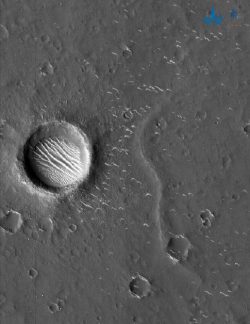Mars’ traffic has just increased by 50%.
Having survived the “seven minutes of terror” during descent, China’s successful deployment of its first Mars rover at about 7.40a.m. EDT on May 15 brought the tally of operational rovers on the Red Planet to a grand total of three (the other two being NASA’s Curiosity since 2012 and the recent Perseverance).
Aptly named after a figure in Chinese folklore associated with light and fire, the Zhurong Mars rover is part of China’s first interplanetary endeavour dubbed the Tianwen-1 mission.
The scientific goals of the mission can be found in this paper.
Akin to the Perseverance rover, the robot will start rolling onto the dusty Martian surface to scour for evidence of water and signs of ancient life.
A major leap in the space-tech race.
The landing was a tremendous feat for China, as it was the first-ever Mars mission to attempt all orbiting, landing and roving components at once, all of which took NASA decades to accomplish.
This catapults China ahead of a number of spacefaring peers.
In recent years, the nation has also launched the world’s first quantum satellite, made a gentle landing on the far side of the moon and returned lunar samples to Earth with automated sampling probes.
They’ve also announced ambitious plans to establish a lunar base and are currently assembling their very own space station.
Considering China initiated their first crewed space program barely two decades ago, the rapid technological progress they’ve made so far is simply mind-boggling and admirable.
 |
| Incredible HD image taken of a crater on the surface of Mars by the Tianwen-1 orbiter. Photo credit: CNSA/Xinhua/Alamy |
Landing at a basin of potential life.
Using a slightly different technique to land compared to previous Mars missions, Zhurong touched down safely thanks to a combination of parachutes and rocket thrusters beneath the lander that cushioned its turbulent fall.
The chosen landing zone is at a Northern hemisphere basin known as Utopia Planitia, reckoned to be the site of an ancient sea.
Scientists discovered the basin has sedimentary layers that could contain evidence of past water – and perhaps even more thrilling – traces of past Martian life.
Super hi-tech robot.
Once ready, Zhurong will start conducting science at the site with its payload of 6 scientific instruments.
A pair of panoramic cameras and a multispectral imager will supply information about the terrain and its composition.
An instrument will fire lasers at rocks to study their composition, similar to that aboard the Perseverance rover.
A magnetometer will work with its counterpart on the orbiter to detect the Martian space magnetic field and the ionosphere current.
A climate system will obtain key atmospheric data such as temperature, pressure, wind speed and direction to monitor Martian surface meteorology.
Perhaps the most exciting instrument aboard Zhurong is the ground-penetrating radar that emits radio waves. When pointed at the surface of the Red Planet, the rover can pick up signals to collect data of what’s underneath, particularly water ice.
NASA’s Viking 2 lander, which landed at a region slightly north of Zhurong’s landing site in 1976, imaged frosts on the Martian surface. In 2016, NASA also confirmed with its Reconnaissance orbiter that beneath the cracked, pitted plains of Utopia Planitia lies a huge amount of frozen water.
It will be interesting to see what Zhurong can further uncover about the area and the valuable resource it holds.
The pockets of ice could prove practical for any future crewed Mars missions. Any pockets of water or brine protected from radiation could also serve as habitats for simple lifeforms.
Ushering in yet another chapter of space exploration.
Fantastic news for astronomists and planetary scientists worldwide – China will openly share its scientific data and results from the Tianwen-1 mission, as they have done so from its lunar exploration missions.
Complementing scientific research being carried out by the Curiosity and Perseverance rovers at the ancient lakes of Gale and Jezero craters, we are looking forward to seeing Zhurong making even more magic at Utopia Planitia.
Huge congratulations to China from everyone at Team_DUG. We admire your aspirations and for pushing human-kind further and advancing our knowledge of the Universe.
Main image: Model of China’s first Mars Rover, Zhurong. Photo credit: SCMP




































